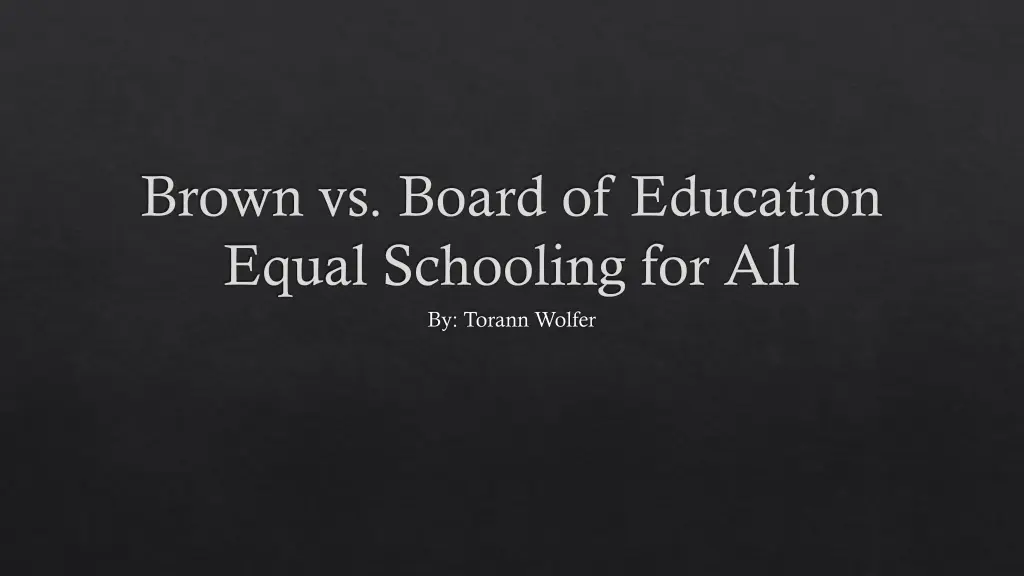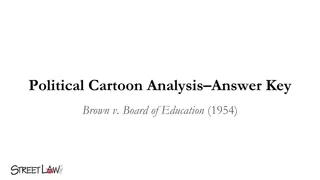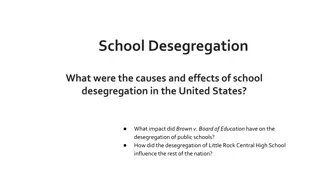
Brown v. Board of Education - Desegregation Case Overview
Explore the historic Brown v. Board of Education case, which led to the desegregation of schools across the U.S. in the 1950s. Learn about the background, main case facts, outcome, and significance of this landmark ruling that aimed to provide equal schooling for all.
Download Presentation

Please find below an Image/Link to download the presentation.
The content on the website is provided AS IS for your information and personal use only. It may not be sold, licensed, or shared on other websites without obtaining consent from the author. If you encounter any issues during the download, it is possible that the publisher has removed the file from their server.
You are allowed to download the files provided on this website for personal or commercial use, subject to the condition that they are used lawfully. All files are the property of their respective owners.
The content on the website is provided AS IS for your information and personal use only. It may not be sold, licensed, or shared on other websites without obtaining consent from the author.
E N D
Presentation Transcript
Brown vs. Board of Education Equal Schooling for All By: Torann Wolfer
Dates of the Case Start- 1951 End- May 17, 1954 This Photo by Unknown Author is licensed under CC BY-NC-ND
Background Information In the twentieth century, the National Association for the Advancement of Colored People (NAACP) began a litigation campaign designed to bring an end to state mandated segregation, calling attention to the shabby accommodations provided for blacks, as well as arguing the damaging psychological effects that segregation had on black school children. One case was brought on behalf of Linda Brown, a third-grader from Topeka, Kansas. Several additional school segregation cases were combined into one, known as Brown v. Board of Education. This case reached the Supreme Court in 1953. This Photo by Unknown Author is licensed under CC BY- NC-ND
Main Case Facts At the time of the Brown v. Board of Education ruling, 17 southern and border states, along with the District of Columbia, required their public schools to be racially segregated. An additional four states Arizona, Kansas, New Mexico and Wyoming permitted local communities to do the same. Although Black and white schools were supposed to be separate but equal in accordance with the Supreme Court s 1896 Plessy v. Ferguson decision, in reality they were anything but. In 1954 southern Black schools received only 60 percent of the per-pupil funding as southern white schools, up from 45 percent in 1940. Many southern Black schools therefore lacked such basic necessities as cafeterias, libraries, gymnasiums, running water and electricity. The Supreme Court included no guidance in Brown v. Board of Education on how to actually implement desegregation. Instead, it called for further court discussions, after which it issued a second unanimous ruling in May 1955. Known as Brown II, this seven-paragraph decision tasked local federal judges with making sure that school authorities integrated with all deliberate speed an ambiguous phrase that repudiated the NAACP s plea for tight deadlines.
Outcome of the case The outcome of the Brown v. Board of Education court case led to the desegregation of schools all across the country. The schools in Topeka, Kansas have now been integrated for about 70 years.
Sources Brown v. Board of Education - Case Background - Bill of Rights Institute 10 Things You Should Know About Brown v. Board of Education - HISTORY





















